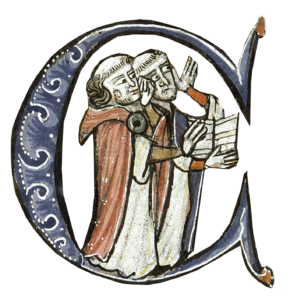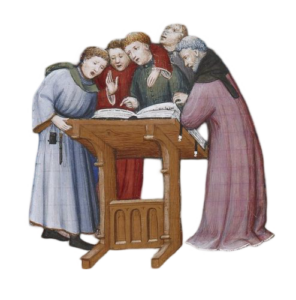2. Repertoires: study, publication, transmission
The historiae or festivals of the cult of the saints (late viiith c. – xvth c. )
The liturgical services composed for the new saint days lie at the intersection of hagiography, history and liturgy; they bring to light numerous artistic creations from monastic, canonical and cathedral schools and, for female institutions, provide new perspectives on gender issues, rebalancing a certain ‘male Middle Ages’ (G. Duby).
In collaboration with Kristin Hoefener, researcher at the Nova University of Lisbon, associate member IRHT
The « map and territory » of Gregorian chant
The differentiation of sung repertoires by a multitude of literary and melodic variants, comparable to the lexical or orthographic variances in dialects in linguistics, allows us to establish precise maps of the different strata and phases of development of the cantilena romana in Latin Europe. Following on from the work of the Solesmes school and Michel Huglo (1923-2012), this is one of my key research themes. This programme combines the differentiation of sung repertoires by literary and melodic variants and results in a cartography of the different strata and phases of development of the cantilena romana in Latin Europe. Chronology and history of the more differentiated politico-cultural spaces.
3. Historiography of plainsong
Historiography of Gregorian chant (9th-20th cent.)
A programme, as yet little studied, brings together the restoration of chant, begun by seculars and laymen, then by the Benedictines, in the 19th century, notably the Abbey of Solesmes, with medieval sources, the texts of Carolingian and early medieval renovators, to provide a more critical understanding of a restoration that has shaped our working tools – which deserve a serious epistemological revision.
In collaboration with Susana Zapke (Stadt Wien Universität)
Benedictines in the East: restoring the liturgical traditions of the Near East
In the midst of the colonial period and the revival of orientalist studies promoted by Pope Leo XIII (1894), here is one of the cultural heritages of humanity, the Syriac, Chaldean and Maronite chants, which these monks, missionaries and ethnologists saved from oblivion, at a time of revival of ancient and Byzantine music and the restoration of Gregorian chant. Dom Jeannin and Dom Parisot, monks of Marseille, Solesmes and Ligugé, have left important archives in the collections of the abbeys of Ganagobie, Ligugé, Belloc and Solesmes, as well as in the Levant, such as Charfé (Lebanon), the seat of a Syrian seminary.
In collaboration with Daniel-Odon Hurel (LEM UMR 8584/Hastec); P. Youssef Dergham (Syrian Seminary of Charfé, Lebanon), Nidaa Abu Mrad (Antonine University, Beirut).




